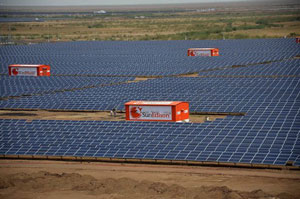India made an astounding announcement, that it is quintupling its ambitious solar target of 20 gigawatts (GW) by 2020 to 100 GW by 2022. It also says it will install 8 GW of wind every year.
To give you an idea of how much solar that is, it’s equal to all the capacity installed worldwide as of 2012! China’s target is 70 GW by 2017, which would mean tripling its current capacity.
Energy Minister Piyush Goyal says the government’s goal is for solar to reach grid parity, making it bankable and self-sufficient as an industry. "Renewable power is the future of the country and will be supported fully," he says, and the government plans to infuse the industry with $150 billion to combat energy poverty.
Since taking office in May, Prime Minister Modi has promised a "saffron" revolution that brings solar lighting to all 400 million people that still live in the dark by 2019.
Rooftop solar will reach grid parity this year and there’s at least 100 GW potential in that market alone, Tobias Engelmeier of Bridge to India told PVTech. "As the economics of electricity continues to shift in favor of local solar solutions, I am convinced that we will see phenomenal growth in the next five years." Indeed, India could have 145 GW installed by 2024, he says.
Others aren’t convinced. Without a firm action plan, India’s aim may just remain an aspiration. India would have to pick up the pace of renewable energy installations by a factor of seven – from 3 GW a year now to 20 GW a year. Serious upgrades in transmission infrastructure would be needed as well as strong incentives, says Bloomberg New Energy Finance.
A solar farm in India:

This week, the Indian government released its first comprehensive assessment of the country’s solar potential. At 749 GW, it is almost triple the total current power generation capacity of 255 GW from all sources, reports Bloomberg New Energy Finance.
Also this week, the US Export-Import Bank signed a $1 billion agreement with the Indian Renewable Energy Development Agency to give India’s power generators loans to purchase US-made equipment. This is in addition to more than $350 million the Bank has approved since 2009.
Also Doubles Down on Coal
Even with these remarkable goals, India is delving deeper into coal. Amazingly, Goyal also promises to double India’s use of domestic coal to more than a billion tons a year by 2019, and may even privatize coal mining to speed up extraction.
"If India goes deeper and deeper into coal, we’re all doomed and no place will suffer more than India," one of the world’s leading climate scientists Veerabhadran Ramanathan, director of Scripps’ Center for Atmospheric Sciences, told the NY Times. The world is on the verge of irreversible climate change and could be pushed over the edge by these policies, no matter how much solar they use, he says.
But Goyal insists, "India’s development imperatives cannot be sacrificed at the altar of potential climate changes many years in the future. The West will have to recognize we have the needs of the poor."
After China’s watershed agreement with the US this month, India is now the biggest obstacle to a global climate pact.
Over the past five years, India increased coal-fired power plant capacity 73%; now it needs coal mining to catch up to fuel the plants instead of having to import.
And that brings more problems for the "poor" people Goyal wants to help. "We need to shift these people to corporate villages far from the coal fields," TK Lahiry, chairman of government-owned Bharat Coking Coal, told the NY Times. Tens of thousands of residents must be displaced, and "Evictions are done too slowly."
People who live within range of strip mines suffer from respiratory and other diseases, and mercury poisoning is a curse, contorting their bodies, decaying teeth and causing mental disorders," reports the NY Times. "The city of Dhanbad resembles a postapocalyptic movie set, with villages surrounded by barren slag heaps half-obscured by acrid smoke spewing from a century-old fire slowly burning through buried coal seams."
To his credit, Goyal has introduced incentives to close the oldest, least efficient power plants, and doubled the tax on coal to finance clean energy.
Read our article, Modi’s Renewable Energy Revolution for India.
Read the full story, Coal Rush in India Could Tip Balance on Climate Change:
